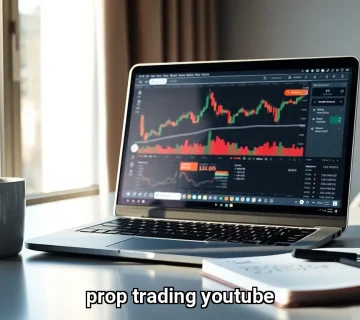Navigating the world of finance can often feel like traversing a vast maze, especially when it comes to understanding the roles of various trading entities. One of the most puzzling questions that arises is are prop trading firms buy side? Prop trading firms, like Propx Pro, are known for their unique trading strategies and risk profiles, but the answer to this question isn’t as straightforward as it may seem. These firms typically use their own capital to engage in a variety of trading activities, which can span both the buy-side and sell-side of the market.
While they may share similarities with buy-side firms in terms of managing their own capital for profit, they also engage in strategies commonly associated with the sell-side, such as market making. Understanding the operational focus of these firms is key to determining where they fit within the broader financial ecosystem.
Prop firm trading operate using their own capital to engage in a wide range of trading activities, blurring the lines that traditionally separate buy-side firms, like hedge funds, from sell-side operations that focus on client services. This ambiguity has led to what many refer to as the “Grey Zone” of finance, where the classification of these firms hinges on their operational focus and trading strategies.
As you delve deeper into this topic, you’ll uncover the intricate distinctions that set prop trading firms apart, as well as their evolving roles in the financial ecosystem. Stay tuned to explore how these firms navigate the markets and the implications for traders and investors alike, as understanding their position can provide valuable insights into the broader trading environment.

Are Prop Trading Firms Buy Side?
The classification of prop trading firms within the financial ecosystem often raises questions, particularly regarding are prop trading firms buy side or sell side of trading operations. Proprietary trading firms, like Propx Pro, typically operate as market makers, engaging in high-frequency trading and providing liquidity to the markets. This positioning differentiates them from traditional buy-side firms, which typically focus on asset management and long-term investments.
Prop trading firms do not fall neatly into either category and often exist in what’s referred to as a “Grey Zone,” a term that describes entities whose operations don’t align exclusively with the buy-side or sell-side. Some firms, such as Propx Pro, might lean towards speculative strategies that mirror hedge fund activities, further complicating this classification. Thus, understanding their operational focus and strategies is essential to determine their role in the broader financial ecosystem.
In the context of buy-side roles, firms like hedge funds and asset managers typically invest their own capital or manage client funds with the goal of generating returns. Conversely, prop trading firms typically utilize their own capital to trade market instruments, which can lead to a broader range of trading strategies and risk profiles.
The compensation structures at prop trading firms can also be more lucrative than those found on the sell side, where brokers earn commissions or fees. This higher earning potential often attracts skilled traders, especially during periods of market volatility, such as those experienced during the COVID pandemic. The fast-paced nature of prop trading can lead to substantial financial rewards for traders who successfully navigate the complexities of the market, further distinguishing prop firms from their buy-side counterparts.
The performance of prop trading firms has fluctuated in recent years, with some firms facing challenges compared to their previous successes. QuantCoach, a professional in the buy-side sector, noted that many prop firms did not achieve the same level of profits this past year, prompting a reevaluation of their strategies.
However, buoyed by their historical performance, many of these firms expanded rapidly during the pandemic, increasing their intern classes and retaining promising talent for full-time roles. Such dynamics exemplify the unique positioning of prop trading firms in the financial landscape, as they adapt their strategies to changing market conditions. The evolution of their operational models not only highlights the resilience of these firms but also underscores their critical role in maintaining market liquidity and efficiency.
Understanding Prop Trading Firms
Prop trading firms, or proprietary trading firms, are entities that trade financial instruments using their own capital, with the aim of generating profits. These firms often engage in a variety of trading strategies, including arbitrage, market making, and quantitative trading. By leveraging their own capital, they aim to capitalize on market inefficiencies and provide liquidity to the markets. The operational flexibility of prop firms allows them to react swiftly to market changes, making them significant players in the trading arena. Their ability to swiftly adapt to market conditions can create opportunities for both traders and investors, as they often provide critical insights and liquidity during volatile periods.
One of the significant characteristics of prop trading firms is their approach to risk management. Many firms, including Propx Pro, allow traders to operate with a certain level of leverage, which can amplify both potential gains and losses. For example, Propx Pro offers demo accounts that are actually live accounts connected to direct liquidity providers (LP), giving traders the experience of real market conditions. However, the leverage provided can lead to significant losses, particularly in unfavorable market conditions. Understanding the risk-reward dynamic is crucial for anyone engaging with a prop firm.
Traders at Propx Pro need to be well-versed in risk management techniques to protect their capital while maximizing their trading potential, as the fast-paced nature of proprietary trading can cause rapid fluctuations in account balances. The ability to manage risk effectively is essential to long-term success in this high-stakes environment.
Moreover, prop trading firms often differentiate themselves through their trading conditions, which can vary widely among firms. Some firms impose maximum loss limits regardless of the overall account balance, while others may allow more flexibility in trading strategies. This variability is key for traders to consider when selecting a prop firm that aligns with their trading style and risk tolerance. The choice of a prop trading firm can significantly impact a trader’s success, as firms with supportive environments and robust risk management protocols can foster growth and development. Consequently, aspiring traders must conduct thorough research to identify firms that not only match their trading preferences but also provide the necessary support and resources for success.

The Role of Buy Side in Trading
The buy side of the trading world is primarily concerned with acquiring securities and other financial instruments for investment purposes. This sector includes hedge funds, mutual funds, pension funds, and private equity firms, all of which aim to generate returns on investments for their clients or for their own balance sheets. The buy side engages in extensive research and analysis to make informed investment decisions, often employing financial analysts, portfolio managers, and quantitative researchers. The thorough analytical approach adopted by buy-side firms helps them identify lucrative investment opportunities, ultimately benefiting their clients and stakeholders.
In contrast, prop trading firms focus on trading for their own profit, which differentiates them from traditional buy-side firms that manage client funds. While both sectors can employ sophisticated trading strategies, the motivation behind each type of trading is fundamentally different. Prop firms are primarily concerned with generating profits through market-making and arbitrage opportunities, whereas buy-side firms are focused on long-term investment returns. This distinction is crucial for understanding the operational dynamics and risk profiles associated with each sector, as their differing objectives lead to varied approaches to trading and risk management.
The distinction between these two sectors becomes particularly relevant when considering compensation structures and career trajectories. Buy-side professionals often enjoy stable income and bonuses tied to fund performance, whereas traders in prop firms may have variable compensation based on individual trading performance. This can create a more dynamic and high-pressure environment within prop trading firms, attracting individuals who thrive in competitive settings. The allure of high earnings in prop trading can be a double-edged sword, as traders must consistently perform at a high level to maintain their income, which can lead to increased stress and competition among peers.
Exploring Prop Trading Strategies
Prop trading strategies can be diverse and are often tailored to the specific market conditions and trader preferences. Some common strategies employed by prop trading firms include high-frequency trading, statistical arbitrage, and market making. Each of these strategies requires a different skill set and approach to risk management. Understanding the nuances of these strategies is essential for traders looking to succeed in the competitive landscape of proprietary trading.
High-frequency trading (HFT) is a strategy that utilizes sophisticated algorithms to execute a large number of orders at extremely high speeds. This technique relies on technology and data analysis to identify and exploit minute price discrepancies in the market. HFT can be highly profitable but requires significant investment in technology and infrastructure. The operational demands of HFT necessitate a deep understanding of market mechanics and the ability to react swiftly to changes, as even a fraction of a second can be the difference between profit and loss.
Statistical arbitrage involves using mathematical models to identify price relationships between various securities. Traders employing this strategy look for mispricings in correlated assets, aiming to profit from the convergence of prices. This strategy can be effective in both volatile and stable market conditions, depending on the execution and analysis of the underlying data. Traders must possess strong analytical skills and a thorough understanding of market dynamics to successfully implement statistical arbitrage, as misjudging correlations can lead to significant losses.
Market making is another prevalent strategy among prop firms, wherein traders provide liquidity to the market by placing buy and sell orders for various financial instruments. This practice can help stabilize markets, but it also exposes traders to risks associated with price fluctuations. Successful market makers must be adept at managing these risks while ensuring they remain competitive in their pricing. The balance between providing liquidity and managing risk is delicate, requiring market makers to continuously assess market conditions and adjust their strategies accordingly.
Differences Between Buy Side and Sell Side
The distinctions between the buy side and sell side of finance are crucial for understanding the broader ecosystem of trading and investment. The buy side, as previously mentioned, is focused on acquiring and managing assets to generate returns. In contrast, the sell side consists of firms that facilitate transactions and provide services to the buy side, including brokers and investment banks. However, when asking are prop trading firms buy side, the answer is not so straightforward. Prop trading firms, like Propx Pro, operate in a unique space that blends elements of both sides.
While they do engage in buying and selling financial instruments, their primary function is to trade for their own account, aiming to generate profits rather than facilitating trades for clients. This positioning makes prop trading firms somewhat distinct from traditional buy-side or sell-side classifications, as they combine characteristics of both. The dynamic interplay between these two sides remains critical for the functioning of the financial markets, as buy-side firms rely on sell-side firms for execution and analysis, and prop trading firms add liquidity and market efficiency.
One of the key differences lies in the nature of relationships each side maintains. Buy-side firms typically engage in long-term relationships with their clients, providing tailored investment strategies to meet specific financial goals. On the other hand, sell-side firms often focus on executing trades and providing market research, analysis, and advisory services. This relationship-driven approach distinguishes the buy side from the sell side, where transactions are often more transactional in nature. The contrasting relationship styles can influence how information is shared and how trading strategies are developed, ultimately impacting market efficiency.
Furthermore, the compensation structures between the two sides can vary significantly. Buy-side professionals may receive bonuses linked to fund performance and client satisfaction, while sell-side employees typically earn commissions based on the volume of trades executed. This difference can lead to varying workplace cultures, where buy-side environments may emphasize collaboration and long-term strategy, while sell-side firms might prioritize performance and quick results. The emphasis on results and performance in sell-side firms can create a fast-paced atmosphere, while buy-side firms may foster a more measured and research-oriented environment.

Navigating the World of Prop Trading Firms
Navigating the world of prop trading firms can be a complex endeavor, particularly for those new to trading or looking to transition from traditional investment roles. Understanding the specific characteristics and offerings of various prop firms is essential for making informed decisions. Factors to consider include trading conditions, fees, and the types of assets offered for trading. The diversity of prop firms in terms of their operational models and trading styles adds another layer of complexity to the decision-making process.
Many prop trading firms provide various challenge options at favorable prices, allowing traders to demonstrate their skills before gaining access to larger capital. This can be an appealing pathway for aspiring traders looking to prove their capabilities without risking their own funds upfront. However, it is crucial to thoroughly research any firm before committing, as the quality of training, support, and technology can vary widely. Traders should seek firms with robust educational resources and a supportive community, as these factors can significantly enhance their trading journey.
When selecting a prop trading firm, traders should also consider the trading platforms available. Different platforms offer unique features and functionalities that can enhance the trading experience. Some firms may provide access to advanced charting tools, while others may focus on user-friendly interfaces for quick execution. Choosing a platform that aligns with one’s trading preferences can significantly impact performance and satisfaction. A seamless trading experience can make a substantial difference in a trader’s ability to execute strategies effectively.
Additionally, understanding the risk management protocols within a prop firm is vital. Many firms allow traders to operate with substantial leverage, which can amplify both profits and losses. It is important for traders to have a solid grasp of their risk tolerance and to employ sound risk management practices to mitigate potential losses. Developing a comprehensive risk management plan is essential for long-term success in prop trading, as the fast-paced nature of the environment can lead to rapid changes in account balances. Adopting prudent risk management strategies can help traders navigate the inherent uncertainties of the market while maximizing their potential for success.
In summary, the classification of prop trading firms often leads to discussions about their role within the buy-side and sell-side structures of finance. While they operate primarily for their own profit, the strategies and approaches employed by these firms can closely resemble those of traditional buy-side entities. As traders explore opportunities within prop trading firms, platforms like Propx Pro can provide valuable insights and resources to support their journey in this dynamic field. The evolving landscape of proprietary trading presents both challenges and opportunities, and staying informed about the latest trends and developments in this sector will empower traders to make informed decisions.
Unraveling the Complexity of Proprietary Trading Firms
In the intricate landscape of finance, proprietary trading firms occupy a unique and often misunderstood position. By leveraging their own capital to engage in a variety of trading strategies, these firms blur the lines between traditional buy-side and sell-side classifications. Their primary focus on profit generation through market-making and arbitrage not only distinguishes them from conventional buy-side entities but also highlights their adaptive strategies in response to market dynamics. This adaptability allows prop firms to thrive in varying market conditions, making them integral players in the financial ecosystem.
As we have explored, prop trading firms thrive in the “Grey Zone” of finance, where their operational focus dictates their classification. Their diverse strategies, from high-frequency trading to statistical arbitrage, underscore the complexity and dynamic nature of their role in the financial ecosystem. Additionally, the competitive environment of prop trading firms, characterized by lucrative compensation structures and a high-pressure atmosphere, attracts skilled traders looking for significant rewards. The landscape of proprietary trading is continually evolving, and the firms that can adapt to these changes are more likely to succeed.
As you continue to navigate this multifaceted world, understanding the nuances of proprietary trading will be crucial. The implications for both traders and investors are significant, as prop firms not only provide liquidity and stabilize markets but also challenge traditional notions of trading and investment. In this ever-evolving sector, staying informed about the operational models and strategies of prop trading firms will empower you to make informed decisions and capitalize on the opportunities they present.
Furthermore, it is essential to recognize that prop trading firms are an integral part of the buy side, even if their operational methodologies differ from traditional buy-side firms. Their unique positioning offers a range of opportunities and challenges that are important for anyone involved in the financial markets to understand.




No comment